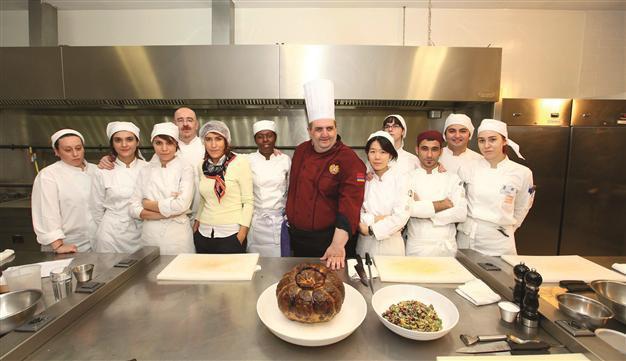
Award-winning Armenian chef Grigori K. Antinyan cooked dishes with university students within the project ‘diplomacy for food.’
Khashntur Vahagni, an ancient lamb dish named after the Armenian god of war, Vahagni, a pre-Chrstian deity, was the main dish cooked by award-winning Chef Grigori K. Antinyan at a dinner organized as part of the “food for diplomacy” project.
Ünal Çeviköz, the first speaker of the Food for Diplomacy project, pays homage to Mıgırdıç Hekimyan, one of Ottoman Turkey’s first wine producers:
“This is a story about an Ottoman citizen and his interest in the production of wine. The reason for that interest was a disaster that the European wine industry suffered.
“It was in 1874 when American grape vines were first brought across the Atlantic Ocean for the purpose of introducing a new brand to Europe. Unfortunately, those vines carried phylloxera, an agricultural disease which ruins vineyards. The vineyards in Germany were the first to be affected by the disease, which spread like an epidemic in a very short time and created a disaster for the entire European wine production industry at the end of the 19th century and into the beginning of 20th century. All the vineyards dried, and grape and wine production in Europe practically stopped. European merchants started to import wine into the Ottoman Empire through ports in Foça and Galata. This gave investors an opportunity to expand wine production into the Ottoman Empire, and new vineyards were planted.
“This is the time when a modest man named Hekimyan Mıgırdıç Efendi, who lived at Poland Street, No: 45 in Beyoğlu-Istanbul, got interested in wine production. He thought his land in the Tuzla-Pendik area would be quite suitable for the purpose. It was fertile land of around eight to 10 acres. If everything went according to expectations, within around four to five years he would be able to produce up to eight tons of grapes annually, which would mean five tons of wine.
“Hekimyan was apparently a good accountant. His records on the transformation of his land into a vineyard show the registration of every piece in detail, starting in 1912. How many investments he made and his expenses were very carefully put into his black covered notebook, in the proper format of a responsible merchant. The first years of the notebook were covered extensively on numerous pages; however, the records start to diminish as time goes on and ultimately, in 1922, the notebook ends with a balance of a loss. Hekimyan’s wine production adventure had come to an end within 10 years.
“What he could not have foreseen calculate was the First World War that started in 1914 and which became a disaster for the whole European continent. The years after the war were the Turkish War of Independence, with the Ottoman Empire at war with countries that it had initially intended to sell wine to. Nobody was thinking of wine production or commerce anymore; the sovereignty and independence of the country was instead the priority. Hekimyan retired back to his house on Poland Street, No. 45 in Beyoğlu-Istanbul, continued to live there, and peacefully died in 1927 as a citizen of the Republic of Turkey. But who was Mıgırdıç Hekimyan?
“He was born in 1847 as a citizen of the Ottoman Empire. He was one of 10 students in forestry school who graduated on 21 July 1868 in Istanbul. He continued his education in the Raphaelian School in Italy, and later in France. After his return to Istanbul, he became a teacher in the School of Forestry and kept this position from 1881 to 1893. Mıgırdıç Efendi, as he observed there was not enough scientific material in the Turkish language on forestry, wrote a book which was entitled “İlm-i Nebatat ve Teşhis-i Ahşap” which translates into English as “The Basics of Botanics and Anatomy of Trees.” The book is 391 pages long and has a very good index, as well as an extensive glossary. One of the most interesting things about it is that all the scientific terminology is in Turkish; all the foreign scientific terminology relating to the subject matter of botanics is explained, translated or reformulated into Turkish vocabulary.
“Hekimyan also served as the undersecretary of finance and accounting for the Sultan and continued his teaching position in the School of Agriculture and Forestry in Istanbul, which is now the Forestry Faculty of Istanbul University today. He was born in 1848 as a subject of the Ottoman Empire and died in 1927 as a citizen of the Republic of Turkey.”